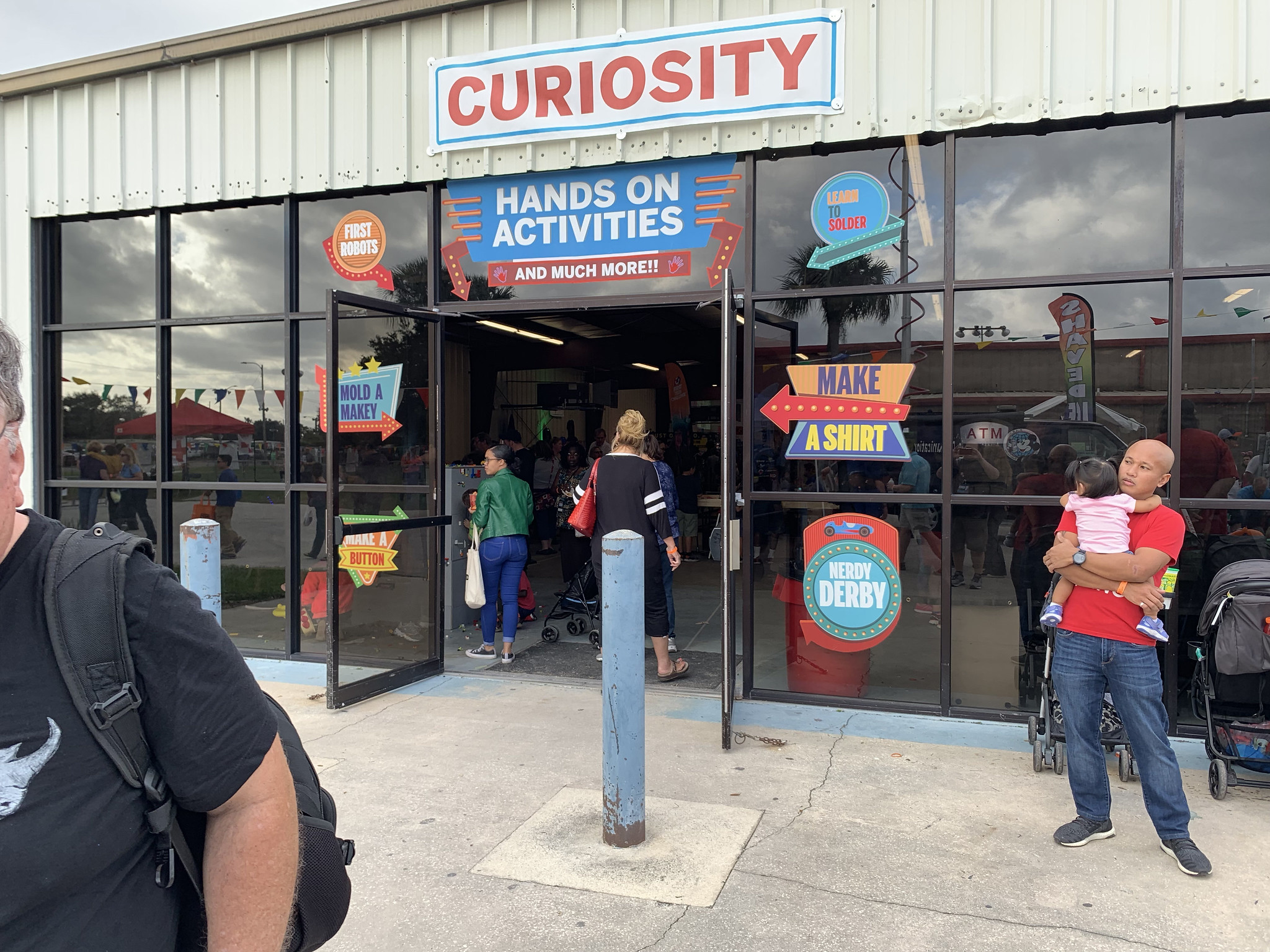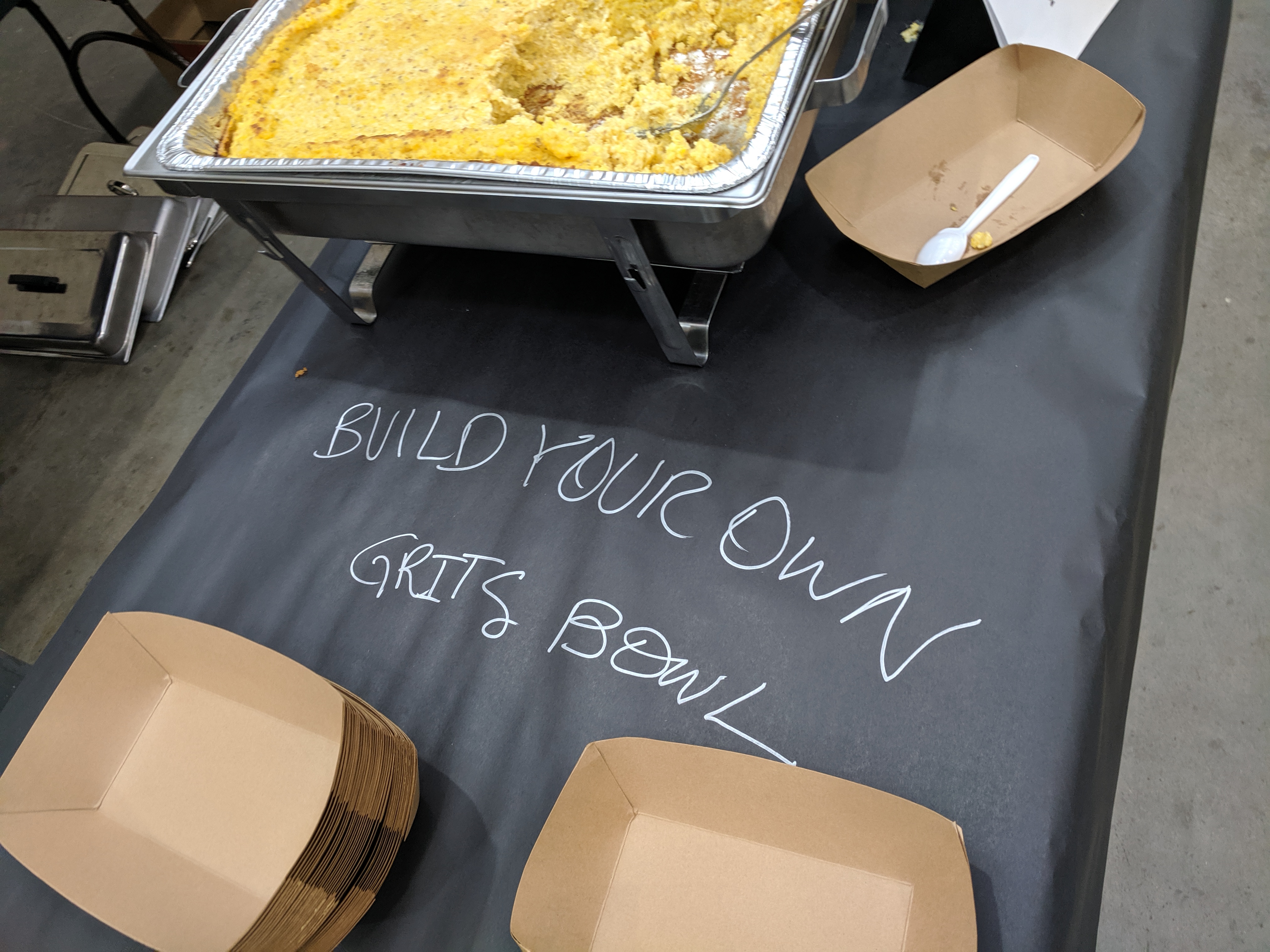Types of Signage
Exterior Signage
One of the primary roles of exterior signage should be to get people into your event. This may involve telling people what building you are in, or where to park, or just where to enter the building. These may seem like simple things, but if you've got thousands of people coming to your event, even if the majority can easily figure it out, there's still a percentage that will appreciate extra guidance in getting there.
Signage is also very valuable for makers, who often come from out of town. If you're driving an hour or more to get to an event to show off the awesome things you make, the last thing you want to do when you arrive is circle the block trying to figure out where to go, where to load in, where to park, etc. Hopefully this information has been sent to makers ahead of time, but from experience, we can tell you that signage will still help those makers who show up and seem to have no idea where to go.
Exterior signage can also serve as marketing. People unfamiliar with your event might see a sign and want to learn more, they might look it up online, or just show up at the door and ask "What is this thing?" and then join the fun.
Interior Signage
Interior signage will help people find things once they are inside the venue. If your event is large enough to have more than one thing going on, signage can direct people to what they want to see and do. If you're hosting makers at your event, it's very valuable to provide each maker with a sign they can put at their table or booth. Some of this signage can overlap with what you have outside, think of navigation, promotion and general event branding.
Digital Signage
Digital Signage is loosely digital screens, think TVs, Monitors, Projectors, etc. which can provide more information in less space, and change in real time. These are particularly useful for showing schedules which are often dynamic up until the start of your event. Or if you have a stage, great for showing who is on stage or up next. If something is cancelled it could be easy to load another slide up so screens show the info to your attendees. If you have a promotional video or some dynamic content it can really catch the eye of your attendees and draw them to something.
TVs
Smart TVs are readily available now, they usually have some sort of playback capability where you can load a deck of images on a USB jump drive and it will loop them throughout the event. Some regular TVs have this same capability. You can add a Roku, AppleTV, etc. if you dont have this ability on your "dumb" tvs. If you are in a venue with these TVs already there might be a digital signage solution in place, talk to your venue about this opportunity to brand common spaces with some inexpensive pixels. If your venue does not have these in place, think about what the TVs will be deployed on, a clean solution is a tripod style TV mount, but Tables with a TV on top work as well.
Projectors
You can use projectors running video content, powerpoint slides, or any media playback you want. It can be something you update during the event or static throughout the event. These can be driven by a number of options, same as what you can connect to TVs from the preceding content. Projectors are great for large impact, but remember that in a well lit room, or for a large projection, that the projector needs to be bright enough to have impact. Additionally they can use more power and generate more heat, finally if people can walk in between the screen and projector, they will cast shadows obscuring your content.
Materials
Signs can be made from so many different materials! What is right for your event? Well, that's going to depend on the usage and location of signage, as well as if a sign is meant to be used just once or if it is meant to be reusable.
Outdoor signs may need to stand up to weather conditions that include wind, water (including snow) and extreme heat. Plastic, vinyl, and other durable materials should be used for outdoor signage. Avoid paper (obviously) and anything fragile that can be easily damaged. If you have signage that uses electricity (AC or battery operated) make sure it can operate safely outdoors. Attachment and mounting of outdoor signage is another issue. We've seen signs blow away, fall over, and disintegrate. Keep safety and material usage in mind. More than once we've seen teams have to run out front and reattach signage that has come down or stand up a giant inflatable robot that has fallen over. Don't forget rope, cord, zip ties and sandbags for outdoor signage!
Indoor signage is typically sheltered from weather conditions, though it may be susceptible to other issues. Paper signs are probably the minimum you can do, and laminated signs are typically a step up from that. Again, consider if your signs will be used just once and disposed of, or if you want to collect them at the end of the event and use them again.
Reusable versus Single-Use
Some of your signs can be used again and again, while other signs will be used just once. You'll want to think about materials (mentioned above) when you decide if a sign should be used just once or used again and again, especially since material choice can affect the price of producing a sign.
If you've got a sign that lists the times of performances there's a good chance that will be a single-use sign. Signs with dates are typically used just once (especially if it's the date of your event) but there are ways to reuse signage but cutting off dates or covering dates. While we're on the subject of "single-use signs", it's always worth keeping in mind that makers can make use of all sorts of materials, and signs made from durable materials like coroplast, vinyl, and fabric can be recycled into new signage or other things. Before you toss it all in the dumpster, check with makers to see if they can make use of them.
Reusable signs are best made from durable materials so you can (try to) use them again and again. Signs for your organization, your event name, or activities you'll have at future events, are great candidates for reuse. For instance, if you plan to hold a "Learn to Solder" workshop in the future, it can help to have a sign that lasts.
For any reusable signs, keep storage in mind. Some signs can be stored flat, while others can be rolled up. If you're getting a 20 foot long printed on Sintra (expanded PVC) you'll need to find a place to store it. (Sintra does not take kindly to being folded in half.)
Design
Having effective signage means you should have well designed signage. If your team has a graphic designer, chances are they'll know the fundamentals of developing well designed signage. If your team does not have a dedicated designer, do your best to research and borrow from what other events have done. If your event has a specific brand, be sure that any signage follows the guidelines set for the brand. This might mean using specific colors, fonts, and treatment of logos, etc. (If you use sponsor names/logos on signage, make sure you follow the guidelines from them as well.)
Hopefully the idea of well-designed signs doesn't scare you too much. Every event has limitations, and you might not achieve the goal of well-designed signs. Remember, any signage is better than no signage. If you have to use markers and cardboard for signs, so be it. (Hey, we are makers!) There's also room for fun signage, hand-painted signposts, sculptural signs, strange art that doubles as signage… the sky's the limit.
Limitations
While it may be tempting to dream up crazy ideas for signage, remember that the goal is to provide information in a safe and effective manner. Signs that can fall over, or present a tripping (or climbing) hazard should be evaluated properly before implemented.
Many venues will have limitations on signage. For instance, your venue may have policies that include; no signs attached to the floor, no signs on the wall, no signs on doors, no tape to be used to attach signs, etc. Work with your venue to make sure you are on the same page about where signs can be placed. Often free-standing signs on posts, tripods, etc. that you supply are the safest bet. Some venues may be able to provide tripods or other means of displaying signage. Again, ask questions, work with your venue, and be respectful of the partnership you have with them.
Cost is another limitation you may have to deal with… luckily, makers are resourceful. If your organization is a non-profit putting on a community event, consider asking a local sign shop for a donation of printed signs. You might also offer them an in-kind sponsorship as part of the trade.
Examples

